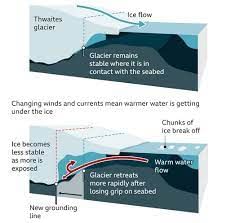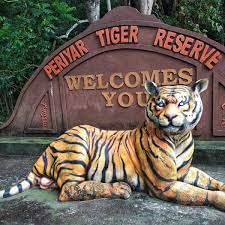UPSC Daily Current Affairs- 17th February 2023 | Current Affairs & Hindu Analysis: Daily, Weekly & Monthly PDF Download
GS-I
Thwaites glacier at mercy of sea warmth increase
Why in News?
The new research suggests that even low amounts of melting can potentially push Thwaites glacier further along the path toward eventual disappearance.
Thwaites Glacier
- Called the Thwaites Glacier, it is 120 km wide at its broadest, fast-moving, and melting fast over the years.
- Because of its size (1.9 lakh square km), it contains enough water to raise the world sea level by more than half a meter.
- Studies have found the amount of ice flowing out of it has nearly doubled over the past 30 years.
- Thwaites’s melting already contributes 4% to global sea-level rise each year. It is estimated that it would collapse into the sea in 200-900 years.
- Thwaites is important for Antarctica as it slows the ice behind it from freely flowing into the ocean. Because of the risk it faces — and poses — Thwaites is often called the Doomsday Glacier.
How is Thwaites glacier melting?
- Thwaites Glacier is melting due to a combination of warming ocean currents and a weakening of the ice shelf that acts as a barrier between the glacier and the ocean.
- The cause of the melting is thought to be the influx of relatively warm bottom water drawn in from the wider ocean.
- In the 1990s it was losing just over 10 billion tonnes of ice a year. Today, it’s more like 80 billion tonnes.
Why is this glacier so important?
- Huge size: Flowing off the west of the Antarctic continent, Thwaites is almost as big as Great Britain. It is one of the largest and most important glaciers in Antarctica, as it acts as a gateway to a vast area of the continent.
- Melting faster: It’s a majestic sight, with its buoyant front, or “ice shelf”, pushing far out to sea and kicking off huge icebergs. But satellite monitoring indicates this glacier is melting at an accelerating rate.
- Seal level rise: Thwaites’ ice loss contributes approximately 4% to the annual rise in global sea-levels, with the potential to add 65cm in total should the whole glacier collapse. Its melting could also destabilize the entire West Antarctic Ice Sheet, leading to a further rise in sea levels.
Source: Indian Express
Folk dance in news: Lavani
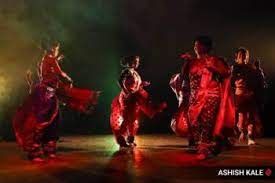
Why in News?
The article is based on the controversy surrounding the Maharashtra folk dance form, Lavani, which has come under criticism for being ‘vulgar’ and ‘obscene’.
What is the Lavani folk art form?
- The word Lavani comes from ‘lavanya’ or beauty.
- Lavani is a traditional folk art form in which women dancers wearing nine-yard-long sarees in bright colours, make-up, and ghunghroos perform on dholak beats on a stage before a live audience.
- As an indigenous art form, Lavani has a history going back several centuries, and it attained particular popularity in the Peshwa era in the 18th century.
- Traditionally, performances were held in front of kings or lords, and for the entertainment of tired soldiers resting during breaks in fighting.
Genres of Lavani
- There are several types of Lavani, of which the most popular is the Shringarik (erotic) kind, in which the lyrics are often teasing, with sensuous dance steps and delicate gestures employed to convey erotic meaning.
- Over the years, Lavani has gained more acceptability among the people, even though certain taboos around it continue.
- The audience has historically been all-male, but in recent years, some women too have begun to attend performances.
Why is it under fire these days?
- Lost its original form: Some also argue that the commercialization of Lavani has led to a loss of authenticity and cultural significance.
- Objectifying women: The criticism of Lavani dance centres on the traditional dance form’s alleged objectification and commodification of women’s bodies.
- Public obscenity: It has been accused of promoting obscenity and vulgarity and reinforcing patriarchal attitudes towards women.
- Communalizing/Stereotyping: Critics have also argued that the dance form perpetuates negative stereotypes of women from marginalized communities, such as the notion that Dalit women are “loose” or sexually promiscuous.
Source: Indian Express
GS-II
Ladakh and the Sixth Schedule
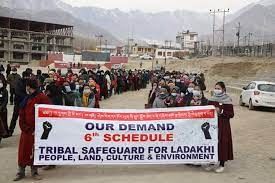
Why in News?
A Ladakhi innovator and engineer completed his five-day “climate fast”, in an effort to draw the attention of leaders to the region’s fragile ecology and to secure its protection under the Sixth Schedule of the Constitution.
Fast for Ladakh’s Fragile Ecology
- The fast highlights that Ladakh’s ecology is highly sensitive to climate change, with melting glaciers posing significant risks to the region’s flora, fauna, and people.
- As a cold desert, Ladakh relies on glaciers to fulfil water needs.
- However, melting glaciers cause the loss of potable water, threaten agriculture practices, erode sustainable practices, and force locals to migrate.
About Ladakh
- Ladakh is a region in the northernmost part of India, bordering China and Pakistan.
- The region is home to several ethnic groups, including the Ladakhi people, who are predominantly Buddhist.
Demand for Sixth Schedule in Ladakh
- There has been a demand from the local tribal communities in Ladakh to extend the provisions of the Sixth Schedule to the region.
- The demand has been primarily driven by concerns over the protection of tribal rights and the preservation of the unique cultural identity of the local communities.
Current administration in Ladakh
- Ladakh was granted Union Territory status in 2019, following the bifurcation of the state of Jammu and Kashmir into two separate Union Territories.
- The administration of Ladakh is currently governed by the Lieutenant Governor of Ladakh and an elected Ladakh Autonomous Hill Development Council (LAHDC).
Benefits of Sixth Schedule in Ladakh
- Meeting tribal aspiration: The Parliamentary standing committee recommended including of Ladakh in the Sixth Schedule because its tribal communities account for 79.61% of its total population.
- Autonomy and self-governance: The extension of the Sixth Schedule to Ladakh could provide greater autonomy and self-governance to the local tribal communities.
- Cultural preservation: It could also help to protect the unique cultural identity of the local communities and preserve their traditional practices and customs.
Challenges to this demand
- No further fragmentation: The demand to extend the Sixth Schedule to Ladakh has faced some opposition from certain quarters, who argue that it could lead to further fragmentation of the region and create new administrative challenges.
- Losing political capital: There are also concerns over the potential impact of the demand on the political and administrative structure of the region.
Conclusion
Overall, the demand to extend the provisions of the Sixth Schedule to Ladakh is a complex issue that requires careful consideration of the needs and aspirations of the local tribal communities, as well as the broader political and administrative context of the region.
Source: The Hindu
Understanding India’s Mental Healthcare Act, 2017

Why in News?
Mental Healthcare Act, 2017The article discusses the challenges faced in implementing India’s Mental Healthcare Act, 2017 and the need for better mental healthcare services in the country.
The Mental Healthcare Act, 2017 is a comprehensive legislation that provides for the protection and promotion of the rights of people with mental illness. Some of the key features of the Act are:
- Decriminalization of suicide: The Act decriminalizes suicide and prohibits the use of inhuman and degrading treatment towards those who attempt suicide.
- Advance directives: The Act allows individuals to make advance directives, specifying the type of treatment they would like to receive in the event of a mental health issue.
- Informed consent: The Act mandates that patients have the right to give or refuse consent to treatment, and to be informed about the benefits, side effects, and alternatives of the treatment.
- Mental health review boards: The Act establishes Mental Health Review Boards at the national and state levels to oversee the implementation of the Act and protect the rights of people with mental illness.
- Prohibition of inhuman treatment: The Act prohibits the use of inhuman treatment methods, including chaining, electroconvulsive therapy (ECT) without anaesthesia, and solitary confinement.
- Right to access mental healthcare: The Act guarantees the right to access mental healthcare services, and mandates the establishment of mental health services in every district.
- Protection of rights and dignity: The Act aims to protect the rights and dignity of people with mental illness, and prohibits discrimination and stigmatization on the basis of mental illness.
- Establishment of a Central Mental Health Authority: The Act establishes a Central Mental Health Authority to regulate mental health services in the country.
- Pity over healthcare institution: The National Human Rights Commission (NHRC) in a report flagged the “inhuman and deplorable” condition of all 46 government-run mental healthcare institutions across the country.
- Prolonged hospitalization: The report notes that the facilities are “illegally” keeping patients long after their recovery, in what is an “infringement of the human rights of mentally ill patients”.
- Need for Assessment: These observations were made after visits to all operational government facilities, to assess the implementation of the Mental Healthcare Act, 2017 (MHA).
- Despite the act’s provisions, mental health institutions in India have been plagued by a lack of adequate infrastructure, staff, and training.
- Patients have reported human rights violations, including abuse, neglect, and violence.
- The Mental Healthcare Act needs effective implementation and oversight to ensure that patients receive the care and treatment they need with dignity and respect.
- This requires increased investment in mental health infrastructure, including facilities, staff, and training.
- Ensuring proper implementation of the Act: There is a need for proper implementation of this act across the country, with a focus on ensuring the rights and dignity of patients in mental healthcare institutions.
- Increasing awareness: Awareness needs to be raised about the Act, and the rights of mental healthcare patients among the general public, healthcare professionals, and law enforcement agencies.
- Providing training and capacity building: Healthcare professionals, including doctors, nurses, and caregivers, need to be trained and equipped with the skills and knowledge to provide quality care and support to mental healthcare patients.
- Strengthening mental healthcare infrastructure: There is a need to strengthen the infrastructure and facilities in mental healthcare institutions, including better staffing, improved physical facilities, and access to quality medication.
- Encouraging community-based care: Community-based care for mental health patients can help reduce the burden on mental healthcare institutions and provide a more supportive environment for patients.
- Promoting human rights: There is a need for greater emphasis on the human rights of mental healthcare patients, including the right to dignity, privacy, and freedom from discrimination and abuse.
Source: The Hindu
GS-III
Periyar Tiger Reserve
Why in News?
A four-day bird survey conducted by the forest department has identified 231 species of birds in the Periyar Tiger Reserve, of which 11 species of birds were not recorded during the previous surveys.
About Periyar Tiger Reserve:
- Location: It is located in the Western Ghats of Kerala.
- It was declared a Tiger Reserve in 1978.
- It gets its name from the River Periyar which has its origin deep inside the reserve.
- Two main rivers, Pamba and Periyar drain the reserve.
- It is home to many tribal communities including the Mannans and the Palians.
- Terrain: Hilly and undulating with a maximum altitude of 2016 m.
- Vegetation: It consists of tropical evergreen, semi- evergreen and moist deciduous
- Flora:
- There are more than 171 species of grasses.
- Important flora includes teak, mangoes, rosewood, jamun, jacarandas, terminalias, tamarind, royal ponciana, bamboos etc.
- Fauna:
- Includes Elephants, Wild Pigs, Sambar, Gaur, Mouse Deer, Dole or Barking Deer, Indian Wild Dog and Tiger.
- The major four species of primates are also found at Periyar - the rare lion-tailed macaque, the Nilgiri Langur, Gee's Golden Langur, Common Langur and Bonnet Macaque.
- It Is also being considered as the habitat of the elusive Nilgiri Tahr.
Source: The Hindu
What is the Reverse Charge Mechanism under Goods and Services Tax (GST)?
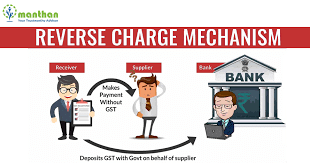
Why in News?
The scrap steel industry recently urged the GST Council to consider their demands for bringing the steel scrap recycling industry under a reverse charge mechanism in line with the transport services.
What is Reverse Charge Mechanism (RCM)?
- It is a mechanism where the recipient of the goods or services is liable to pay GST instead of the supplier.
- Typically, the supplier of goods or services pays the tax on supply. Under the RCM, the recipient of goods or services becomes liable to pay the tax, i.e., the liability of tax payment gets reversed.
- Objectives:
- to widen the scope of levy of tax on various unorganized sectors;
- to exempt specific classes of suppliers of goods/services;
- to tax the import of services (since the supplier is based outside India);
- Under the RCM, the recipient of goods cannot claim an Input tax credit (ITC)as the supplier has not paid any tax for their sales.
What is an Input tax credit (ITC) under GST?
- ITC means GST paid by a taxable person on any purchase of goods and/or services that are used or will be used for business.
- ITC value can be reduced from the GST payable on the sales by the taxable person after fulfilling some conditions.
Source: The Hindu
What is a Payment Aggregator?

Why in News?
Reserve Bank of India (RBI) recently granted payment aggregator licenses to 32 entities.
About Payment Aggregator (PA):
- A PA (also known as a merchant aggregator) is a third-party service provider that allows merchants to accept payment from customers by integrating it into their websites or apps.
- It facilitates different types of payment transactions, including cash/cheque, online payments through multiple payment sources, or offline touchpoints.
- It allows merchants to accept bank transfers without setting up a bank-based merchant account. It means a merchant need not have a merchant account directly with the bank.
- A PA in India is incorporated under the Companies Act 2013.
- A PA can be a bank or a non-bank entity.
- Since a PA handles funds, it requires a license from the RBI.
- Only non-bank payment aggregators require unique authorization from RBI as ‘handling funds’ is considered a part of the normal banking relationships for bank PAs.
- Examples: Amazon (Pay) India, Google India, Razorpay, Pine Labs, etc.
What is a Payment Gateway?
- It is a software service that connects your bank account to the platform where you need to transfer your money.
- It authorizes you to conduct an online transaction through different payment modes like net banking, credit card, debit card, UPI, or other online wallets.
- A Payment gateway plays the role of a third party that securely transfers your money from the bank account to the merchant’s payment portal.
Payment Aggregator v/s Payment gateway:
- A payment gateway is a software that allows online transactions to take place, while a payment aggregator is the inclusion of all these payment gateways.
- While a payment gateway is an intermediary, the payment aggregator is the interface where the payment gateway processes the transactions.
- Most payment aggregators own payment gateways to offer various exclusive services to their merchant customers.
Source: Indian Express
Governing Organ Transplantation in India

Why in News?
The Central Government has recently made major changes in the organ transplant regulations in the country under its ‘one nation, one policy’ rule by removing the 65-year age cap for recipients and allowing them to register in any state and not just their state.
About Organ Transplantation in India:
- The primary legislation governing organ transplantation in India is the Transplantation of Human Organs Act, passed in 1994.
- It provides a system to regulate the removal, storage, and transplantation of human organs for therapeutic purposes and for the prevention of commercial dealings in human organs.
- National Organ transplant programme:
- It is implemented by the Directorate General of Health Services, Government of India.
- Objectives:
- To organize a system of organ and Tissue procurement & distribution for transplantation.
- To promote deceased organ and Tissue donation.
- To train the required manpower.
- To protect vulnerable poor from organ trafficking.
- To monitor organ and tissue transplant services and bring about policy and programme corrections/ changes whenever needed.
- National Organ and Tissue Transplant Organization (NOTTO):
- It is a National level organization set up under the Directorate General of Health Services, Ministry of Health and Family Welfare, Government of India.
- It functions as the apex center for coordinating all activities and networking for the procurement and distribution of organs and tissues and maintaining the registry of organs and tissue donation and transplantation in the country.
Organ donation in India:
- Organ donation means giving part of the body (organ) to a person with end-stage organ disease who needs a transplant.
- In India, organ donations are legal under the Transplantation of Human Organs Act (THOA), 1994, which also legalizes the concept of ‘brain death’, the permanent cessation of all brain functions.
- Organ donation is a voluntary process wherein you can fill up a consent form to donate your organs in the event of your demise.
- Types of organ donation:
- Living Donor Organ Donation:
- A person during his life can donate one kidney, a portion of the pancreas, and a part of the liver.
- Living Donor is any person not less than 18 years of age who voluntarily authorizes the removal of any of his organ and/or tissue, during their lifetime, as per prevalent medical practices for therapeutic purposes.
- The donor can be a family member, relative, friend, neighbour, or in-law.
- Deceased Donor Organ Donation:
- A person can donate multiple organs and tissues after (brain-stem/cardiac) death. Their organ continues to live in another person’s body.
- Deceased Donor is anyone, regardless of age, who can become an organ and tissue donor after their death (Brainstem/Cardiac). Consent of a near relative or a person in lawful possession of the dead body is required.
- Living Donor Organ Donation:
- Eligibility criteria:
- There is no age limit for organ donation. It can be started at as young as six weeks. The only essential thing is the health and condition of your organs.
Source: PIB
|
38 videos|5275 docs|1115 tests
|
FAQs on UPSC Daily Current Affairs- 17th February 2023 - Current Affairs & Hindu Analysis: Daily, Weekly & Monthly
| 1. What is the significance of GS-I, GS-II, and GS-III in the UPSC exam? |  |
| 2. What are the key topics covered in GS-I, GS-II, and GS-III? |  |
| 3. How should I prepare for GS-I, GS-II, and GS-III in the UPSC exam? |  |
| 4. Are there any specific strategies to score well in GS-I, GS-II, and GS-III in the UPSC exam? |  |
| 5. How much weightage do GS-I, GS-II, and GS-III carry in the UPSC exam? |  |

